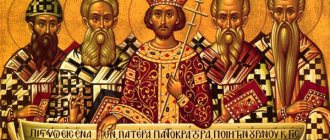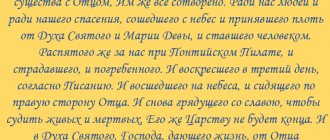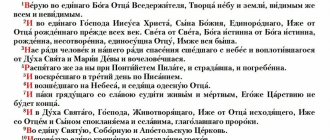Ecumenical Councils
(Greek Σύνοδοι Οικουμενικαί, lat.
Oecumenica Concilia
) - meetings of the predominantly episcopal Christian Church in its universal fullness, at which issues are discussed and decisions of doctrinal (dogmatic), ecclesiastical-political and judicial-disciplinary nature are made.
At the very beginning of the history of the Church, the term " Σύνοδος
" - "Cathedral" was used in relation to any church meeting.
However, during the 3rd century the term began to be used to refer to meetings of bishops (although not only bishops could be present) for the administration of the Church. The earliest known local councils were held in the 2nd century, and by 300 the assembly of provincial bishops had become the customary method of church government. After Constantine I proclaimed toleration of Christians (313) and the persecution ended, bishops from many provinces were able to meet in a general council. However, the idea of an Ecumenical Council and its specific meaning developed slowly. The Church on an imperial scale began to hold Ecumenical
Councils, which implied the participation of representatives of all local churches, usually on the initiative of the Roman Emperors, who often presided over them and gave their decisions the status of state laws.
During the first 9th centuries, Ecumenical Councils are called councils that, with the assistance of secular (imperial) power, were composed of bishops of the Christian Church from various parts of the Greco-Roman Empire - ecumene (Greek: οἰκουμένη, Latin: orbis terrariim
) and the so-called barbarian countries for judging dogmatic and canonical subjects.
The emperor, as guardian (Latin custos
) of the faith and the Church, convened a council, made an appropriation for expenses, appointed the place of its meetings, transferred from one city to another, was personally present and enjoyed the honorary presidency, or appointed his officials to monitor order, dissolved the cathedral and, at the proposal of the cathedral, sealed the acts of the cathedral with his signature.
Ecumenical councils have external and internal distinctive features.
The external features of Ecumenical Councils include:
- participation in the council of representatives of all local churches in the person of heads of churches, bishops or their deputies, authorized and sent (legates) from them;
- canonical correctness in the order of convening the council, forming the composition of participants, conducting and announcing the decisions of the council;
- recognition of the Ecumenical Council by all local churches, both those from which bishops were present at it and those from which there were no representatives.
Internal features of Ecumenical Councils:
- the correspondence of its decrees with the Holy Scriptures, apostolic tradition, dogma and rules of the Universal Church of all previous centuries;
- the unanimous expression on it of the creed, which all local churches adhered to and adhere to everywhere and always;
- legislative activity characteristic of the church only to Ecumenical Councils (drawing up symbols of faith and expounding dogmas).
In resolving questions about the truths of doctrine and moral teaching, the Ecumenical Council has the property of infallibility, as an organ of the Universal Church, guided by the Holy Spirit. Dogmatic definitions and canons of the Ecumenical Councils are placed in the “Book of Rules”, definitions and judicial decisions - in the “Acts”.
Ecumenical councils and local churches
Historically, different Christian churches have different attitudes towards Ecumenical Councils and have their own opinions about their number. Based on the main features of the Ecumenical Council, namely “recognition of the Ecumenical Council by all local churches”
and
“the unanimous expression on it of the creed, which all local churches adhered to and adhere to everywhere and always”
, the indisputable status of the Ecumenical Council, from among the so-called, only the first two have, since they are recognized as Ecumenical by all local churches and their decisions do not cause objections to anyone .
Two Ecumenical Councils are recognized by the Assyrian Church of the East, which was initially isolated from the process of development of dogmas in the Roman Empire due to its isolation in Zoroastrian Persia. Due to the irrelevance of the councils held in Byzantium for the ACV, their decisions were made by it much later. Thus, the Council of Nicea in 325 was adopted at the local council of the ACV under the chairmanship of the Catholicos of Armenia Mar Akak in 410, that is, almost a century later, shortly before the III Council. And the Council of Constantinople of 381 was adopted in 554 at the Council of Mar Joseph, that is, almost two centuries later, when not only the III Council of Ephesus in 431, which condemned Nestorius, had already been held, but also the Council of Chalcedon in 451 and the II Council of Constantinople in 553, at in which the canonical unity of the ACV with the Church of the West (current Orthodox and Catholics) was destroyed. At present, Eucharistic unity is also impossible, if only because the ACV teaching on the Eucharist, accepted by Protestants, makes it absolutely non-Orthodox, despite the fact that the Orthodox and the Church of the East did not anathematize each other. All this indirectly indicates that the opinion of the Church of the East about the number and importance of Ecumenical Councils: in its opinion, the III and subsequent councils were only local councils of the Church of the West, although some of their decisions (for example, the condemnation of Platonism and Origenism at the II Council of Constantinople) East accepted - cannot serve as an undoubted criterion for confirming the status of subsequent councils for the remaining churches.
The Miaphysite Ancient Eastern Churches (Oriental Old Orthodox Churches) had a different attitude towards the Ecumenical Councils, which actively participated in Christian dogmatic creation, both taking part in the councils and expressing their attitude towards them after and often taking individual decisions. The ancient Eastern Orthodox churches of the times of Christological disputes represented the overwhelming majority of regional local churches (against Rome alone and the wavering Constantinople, all the Eastern patriarchates in the empire and beyond, which was presented as “national separatism”), and therefore rejection of the decisions of Chalcedon and subsequent cathedrals by the Ancient Eastern Miaphysite churches, deprived, in their opinion, these cathedrals of the main features of Ecumenical Councils and any cathedrals in general. Accordingly, only three Ecumenical Councils are recognized by the Ancient Eastern Miaphysite Churches; they refuse to recognize the remaining councils even as local ones.
As for the Orthodox churches of the Byzantine tradition, they all recognize the seven Ecumenical Councils held before the Great Schism. The issue of non-recognition of councils, starting from Chalcedon, by the Ecumenical Councils and in general councils by the Miaphysite churches by the Church of Byzantium was resolved by the fact that the Universe (Ecumene) in the minds of the Greeks and Latins was associated with the Roman Empire, and the Ecumenical Church itself - with the patriarchates recognizing the spiritual primacy of the Roman bishops and the administrative power over the church of emperors. The Ancient Eastern churches, which did not take such logic into account, were declared anti-Chalcedonian imperial churches that “fell away from the Ecumenical Church,” and their opinion on the number and status of councils was not taken into account since then, which is why all subsequent councils were considered Ecumenical.
With the gradual weakening of the political influence of Byzantium, especially after the division of the churches - the two halves of the once united Church of the Roman Empire in 1054, the Western Roman Church, correlating catholicity (as an indispensable sign of one indivisible Universal Church) only with the episcopal see of Rome and counting all other local churches “those who fell away from unity with the See of Peter,” began to call their councils Ecumenical, accordingly assigning serial numbers to them. Thus, to date, from the point of view of the Roman Catholic Church, 21 Ecumenical Councils have taken place.
List of cathedrals
Councils recognized by the Orthodox, Catholic, Protestant and Ancient Eastern churches
- The Apostolic Council
of the city - the Jerusalem Council (according to other sources, took place in the city) decided that circumcision and the observance of many Jewish rituals were optional for newly converted pagans.
He also decreed that Christ became incarnate
. - The First Ecumenical Council
of 325 - I Nicaea.
Acceptance of the Creed, condemnation of Arianism, determination of the time of celebration of Easter. He also ruled that Christ became man
, that is, he had not only a human body, but also a human soul. - Second Ecumenical Council
of 381 - I of Constantinople. Recondemnation of Arianism; formulation of the Orthodox doctrine of the Holy Trinity, addition to the Nicene Creed). The Council explains that the humanity of Christ is not a barrier to Him being God. - Third Ecumenical Council
of 431 - Ephesus (condemnation of Nestorius, prohibition of changes to the Nicene-Constantinopolitan Creed (“
let not the Creed of the three hundred and eighteen fathers who were at the Council in Nicaea be abrogated...
” - 1st rule of the Council). This council also explains, that the human nature of Christ is taken without any defect, unchanged. This council is not recognized by the Assyrian Church.
Councils recognized by the Orthodox, Catholic and Protestant churches
- Fourth Ecumenical Council
of 451 - Chalcedon (condemnation of Monophysitism).
Councils recognized by the Orthodox and Catholic Churches
- Fifth Ecumenical Council
of 553 - II of Constantinople (Recognition of the Mother of God as the Ever-Virgin, condemnation of Platonism, Origenism, Nestorian writings and, again, Monophysitism). - Sixth Ecumenical Council
680-681 — III Constantinople (condemnation of monothelitism) (Trullian Council, “Fifth-Sixth Council”, 691 in Orthodoxy is considered as a continuation of the Sixth Ecumenical Council, initially not recognized outside the Byzantine Empire, not recognized by the Roman Catholic Church to this day). - Seventh Ecumenical Council
of 787 - II of Nicaea (condemnation of iconoclasm). The Council notes that since Christ was a man, images of Christ and icons are therefore possible.
Councils called Ecumenical by some theologians and hierarchs of the Orthodox Church
These councils do not have the official status of Ecumenical Councils and are considered local, but in the literature they are called Ecumenical. However, the pre-conciliar meetings held in preparation for the new Pan-Orthodox Council did not recognize these councils as Ecumenical.
8.
Great St. Sophia Cathedral
879-880. - IV of Constantinople (restoration of Photius on the throne of Constantinople, condemnation of the filioque and anathematization of any changes to the Nicene-Constantinople Creed). The Greek Churches unanimously recognize the actual Eighth Ecumenical. 9. 1341-1351 - V of Constantinople (confirmed the theology of hesychasm of St. Gregory Palamas and condemned the philosopher Barlaam and other anti-Palamites who opposed him.)
Councils recognized only by the Catholic Church
8. 869-870 - IV of Constantinople (other) (condemnation of Patriarch Photius of Constantinople). The Council revealed sharp contradictions between Western Christian and Eastern Christian churches; Different churches evaluate the cathedral differently: the Catholic Church recognizes it as the VIII Ecumenical Church, the Orthodox Church does not recognize it. 9. 1123 - I Lateran (approval of the Worms Concordat, which put an end to the struggle for investiture). 10. 1139 - II Lateran (condemnation of Arnold of Brescia). 11. 1179 - III Lateran (condemnation of the Waldensians, Cathars, establishment of the procedure for electing the Pope). 12. 1215 - IV Lateran (condemnation of the Albigensians, Waldensians, authorization of the Inquisition). 13. 1245 - I of Lyons (excommunication of Frederick II of Hohenstaufen). 14. 1274 - II Lyons (union with the Orthodox Church). 15. 1311-1312 — Vienne (abolition of the Templar Order). 16. 1414—1418 - Constance (put an end to the “great schism”, execution of John Hus, conviction of John Wycliffe). 17. 1438—1445 — Ferraro-Florentine (consideration of issues that impede the reunification (union) of the Western and Eastern churches, the dogma of purgatory). 18. 1512—1517 — V Lateran (church reform). 19. 1545—1563 — Tridentine (counter-reformation, liturgical reform). 20. 1869-1870 — Vatican I (dogma of papal infallibility in matters of faith and morals). 21. 1962—1965 — Vatican II (liturgical reform, abolition of the compulsory Latin language in worship).
Robber Cathedrals
Robber councils are councils that claimed to be called Ecumenical, but were rejected by all historical churches.
- 341 - Council of Antioch (Recognition of Arianism as an official teaching).
- 355 - Milan Cathedral (repression of the Arians against their opponents. The cathedral is not recognized by any of the modern churches).
- 449 - Ephesus “Robber” Cathedral.
- 754 - First Iconoclastic Council.
- 815 - Second Iconoclastic Council (cancellation of the decisions of the Second Council of Nicaea).
Nicene-Constantinopolitan Creed and Bible.
1. I believe (Heb.11:1-6, Rom.10:10) in one (Ex.20:3, John 17:3, 1 Cor.8:4-6, Eph.4:6) God the Father ( Gen.1:26, 18:2-10, Ps.2:7-12, Ps.109:3, Sir.51:14, Matt.28:19, John 3:16, John 17:1- 2, 1 John 5:7, 1 Pet. 1:2, Rom. 1:4, 2 Cor. 1:3), the Almighty (Is. 57:15, Ps. 32:9, Ps. 89:3, Ps. 138 :7-12, 1John 3:20, Heb.1:3, Rev.4:8,), Creator of heaven and earth (Gen.1, Jer.10:11-12, Matt.19:4), total (Jer.10:16, Diary 4:24, Diary 17:24) visible and invisible (Job 38:6-7, Col.1:16).
2. And in one Lord (Eph.4:4) Jesus (Luke 1:31-32) Christ (Mark 8:29), the only begotten (Wis.7:21, John 1:14-18, John. 3:16-18, 1 John 4:9) Son of God (Ps. 2:7-12, Ps. 109:3, Is. 9:6, Matt. 3:17, Mark 9:7, Luke 1 :35, Luke 3:21, John 3:16, John 17:1), born of the Father (Is.9:6, Ps.2:7, Sir.51:14, Heb.1:4) before all ages (Prov.8:22-23, Isa.44:6, Ps.109:3, John 17:5, John 8:25, Rev.1:10-17, 3:14), Light from the Light (Wisdom 7:26, Luke 2:32, John 1:4-9, John 8:12, 1 John 1:5-7), the true God of the true God, begotten, not made (Matt. .11:27, John 10:30, John 14:9, John 17:3, 1 John 5:20), consubstantial with the Father (Ex. 3:14, John 5:26, John 10:30 ), through whom all things happened (Ps. 32:6, Ps. 102:26, John 1:3, Col. 1:16-17, Heb. 1:10:12).
3. For the sake of us people (Gen.3:17, Ps.50:7, Job 14:4, 1 John 1:8, 3:4-8, James 3:2, 1 Pet. 4:18, Rom. 5:12) and for our salvation (Mark 1:14-15, John 14:6, Diary 4:12, Titus 3:4-6, 1 Tim. 2:4-6) who came down from heaven (John .3:13), and incarnate (John 1:14, John 3:17) from the Holy Spirit and the Virgin Mary (Gen.3:15, Isa.7:14, Matt.1:20-23, Luke. 1:30-35/43), and became a perfect man (John 2:2-3, 11:35, 1 Tim. 2:5).
4. Crucified (Matt. 16-17ch., Luke 22-23ch., John 18-19ch., John 10:17-18), for us (1 Pet.3:18-19, Gal.2: 19-20, 5:24, Eph.1:7, Gal.3:13, Heb.2:14-15, Rom.8:1-4, Phil.3:10) under Pontius Pilate (Gen.49: 10, Luke 23), and suffered (Ps. 21, Is. 53, Mark 14:65, 15:17-34, Luke 23: 35-40), and buried (Dan. 9: 25-26, Matt.27:63-66, Mark 15:37-47, Matt.12:39-40, 1 Pet.3:19/4:6, Eph.4:9).
5. And risen (Matt. 16:21-23, Matt. 26:32, Luke 24:36-45, John 20:19/27, Diary 24:28, 1 Cor. 15:6/20) in the third day (Jon. 2:1, Matt. 12:39-40, Mark 16:2) according to the Scriptures (Is. 53:5, 1 Cor. 15: 3-4).
6. And ascended into Heaven (Luke 24:51, John 16:28, Diary 1:11, Eph.4:10), and sat on the right side of the Father (Ps. 109:1, Luke 22:69 , Mark 14:62-64, 16:19, Hebrews 8:1).
7. And coming again (John 5:28-29; Rev. 22:12) with glory (Matt. 24:27-30, Matt. 25:31-34/46) to judge (Matt. 12:36 , 25:13/31, 1 Cor.4:5, 2 Pet.3:7-10, 2 Cor.5:10) living and dead (Dan.7:14, 12:2, Isa.26:19, John 5 :25-29, 1 Cor.15:52, Rev.14:11), His Kingdom will have no end (2 Samuel 7:12-13, Luke 1:33).
8. And in the Holy Spirit (Gen.1:2, Matt.3:16, John 3:5-8, Diary 5:13:2), the Lord (Diary 5:3-4), who gives life ( Is.11:1-3, John 3:5, 1 Cor.3:16, Rom.8:14-16/26), who proceeds from the Father (John 14:16/26, 15:26), who must worship and Whom to glorify (Matt. 28:19, John 16:14:15) equally (Ps. 32:6) with the Father (Diary 5:3-4) and the Son (1 Cor. 12:3), - who spoke through the prophets (1 Peter 1:12, 2 Peter 1:21).
9. In one (Matt. 16:18, John 17:11, Eph. 4:4, 1 Cor. 1:10) holy (Matt. 16:18, 18:17, John 15:5-6, 17 :14-20, Eph.3:21, 5:25-27, 1 Tim.3:15, 2 Tim.2:19), conciliar (Diaries 1:15-26, 6:1-5, 8:14, 15 chapters, Col.3:11) and apostolic (Matt.28:16/20, Diary 8:18, 16:4, Eph.2:19-20, 2Thess.2:15, Tit.1:5/ 10-11, 3:10) Church (Matt.18:17-number, Diary 11:26, 1Cor.1:2-place, Eph.4:11-12-different callings, 1Cor.12:29-not to all the gifts of teaching, Diary 14:23, 1 Timothy 5:22 - ordination, Diary 8:17-18, 20:28, 2 Timothy 1:6 - the gift of the Holy Spirit).
10. I acknowledge one baptism (Matt. 28:20, John 3:5, Diary 16:15/33, 19:4, Col. 2:11-12, 1 Cor. 1:16) for the forgiveness of sins (Mk. 2:5, 16:16, John 3:5, Diary 2:38-39, 22:16, Rom.6:3).
11. I look forward to the resurrection of the dead (Matt. 27:52-53, Luke 7:11-15, 8:41-56, John 5:25, 6:54, 12:1-11, 1 Cor. 15:12- 14/19-20/41-53),
12. and the life of the age to come (Matt. 13:43, 25:41-46, Mark 9:47-48, Luke 20:34-38, 1 Cor. 15:41-42, Rev. 20:14-15 ). Amen (truly so).
- ← Metropolitan Anthony (Khrapovitsky) – The Orthodox Church and Emperor Nicholas II (1929).
- HERETICS ARE CHIPS IN THE VINEYARD OF THE LORD. →









